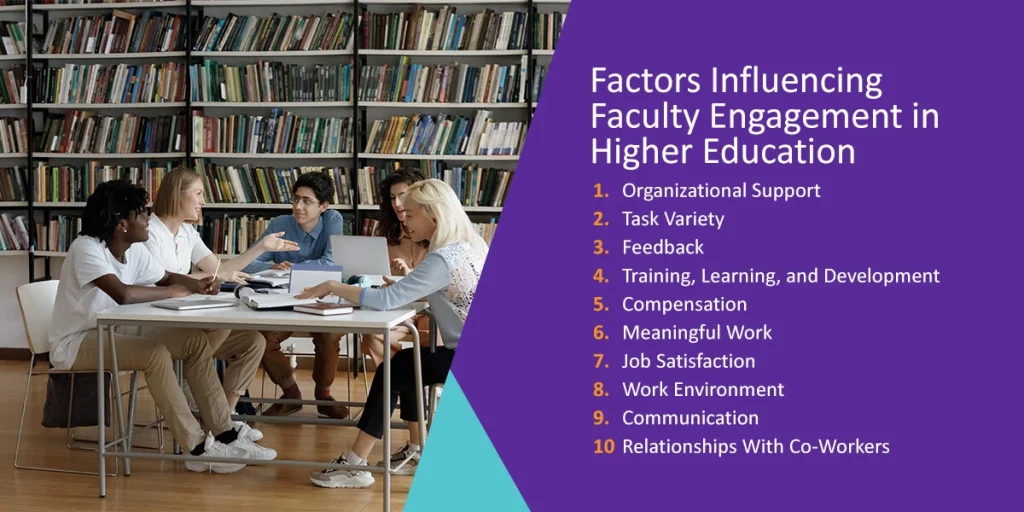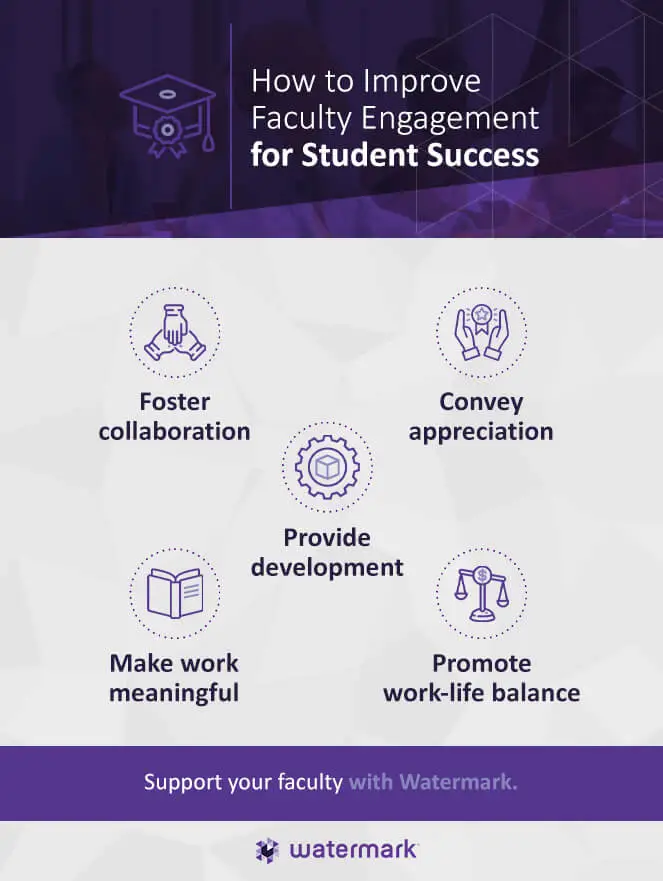




Faculty engagement in higher education can boost student success and help you improve your institution. Many institutions wonder how to increase student engagement in college. Creating a positive space where faculty feel supported to grow, develop, and discuss student plans for success can encourage collaboration and increase contribution to campus culture.
However, many higher education institutions battle low engagement levels and must uncover new strategies to meet faculty needs. Various factors can contribute to reduced interest, but there are also many ways to boost engagement. Read on to discover how to encourage your institution’s faculty members and increase engagement.
Faculty engagement describes your team’s involvement in delivering students a quality academic experience and contributing to the institution’s positive reputation. Faculty members who go above and beyond to actively encourage development and facilitate learning demonstrate a high engagement level. Faculty engagement could include mentoring, reshaping curricula, getting to know students, helping reach campus initiatives, and more. Increasing faculty engagement can positively improve student performance and create an enriching experience for everyone on your campus.

Understanding faculty issues in higher education is the first step to addressing concerns and ensuring you create a positive environment for your team to thrive. Many factors can influence engagement, and each institution may need to dedicate efforts to improve one or more areas specific to its organization. Here are 10 factors that influence faculty engagement in higher education.
When your faculty can identify organizational support, they’re more likely to have a clear sense of identity within the organization, leading to increased performance and engagement.
When faculty continuously perform tasks of minor importance or that do not require their skills, they’re more likely to experience burnout, making it more difficult to become engaged. Introducing a variety of different tasks to your employees can increase interest in the workplace while reducing the effects of stress, anxiety, and burnout.
Using annual faculty reviews and distributing assessments and surveys can give your faculty the input they need to improve. For example, course evaluations and surveys can address challenges for college professors, enlighten instructors about teaching strategies, and provide a foundation for reshaping the curriculum.
Providing your faculty and staff with professional development opportunities like workshops and training can enable them to find new methods to complete tasks, structure lesson plans, and create a more enriching environment. With the right tools in place, and the knowledge necessary to support student success, faculty and coaches can develop improved strategies and plans.
According to research, providing fair and reliable compensation is a great way to reduce employee stress and anxiety. Those who make enough money each year to support themselves are more likely to experience reduced financial stress, increased job performance, and improved emotional well-being.
Performing repetitive daily tasks can discourage faculty and staff. These chores can become mundane and impede faculty job satisfaction, making your team feel like they are not using their broad skill set to complete meaningful work. Make sure your faculty and staff have meaningful tasks on their to-do lists. Employees are likelier to feel their work has a purpose with tasks that highly impact student success.
Job satisfaction is one of the best predictors of engagement and performance. Those who feel happy at their jobs are more likely to complete deep work and have higher levels of engagement. If your employees feel that their tasks are meaningless, they are less likely to perform well at work or engage in workplace culture.
A workplace that promotes growth and learning guides faculty to a more positive experience. If a work environment is unfriendly, has little room for development, and discourages asking for assistance, it becomes much more challenging for faculty to feel job satisfaction and reach a high level of engagement.
Information feedback and flow directly impact faculty engagement. Discussions with your faculty and ensuring everyone completes the tasks they need for institutional and personal success can increase faculty engagement.
Workplace relationships can hinder or improve job satisfaction and emotional well-being. Building a collaborative and positive environment can foster respect, trust, and communication, leading faculty to higher engagement levels.
Understanding how faculty can contribute to student success helps determine what steps institutions can take to support their staff and improve their college or university processes. The more satisfied faculty feel in their career and life choices, the less likely they are to look for a new job. Satisfaction leads to commitment to growth in their current environment, meaning faculty feel more involved in student success than ever before.
With the proper materials, support, and equipment, faculty can better invest their efforts into your institution, creating a more fulfilling student experience. Your team may feel more inclined to know your students personally and give them the tools they need to succeed.
Additionally, engagement affects institutional finances. With a strong team and high levels of engagement, your institution can become more financially stable and provide the academic resources you need to support your students, such as writing centers and internship offices.

A disengaged team can severely impact your institution and the campus experience. Thankfully, there are plenty of ways you can uplift your team and equip them with everything they need to succeed. From encouraging conversations to offering incentives, you can support your team and boost engagement. Here are seven effective strategies for increasing faculty engagement.
Encourage your team to have frequent discussions among colleagues, leaders, and co-workers. Provide opportunities for your team to share ideas, ask questions, and get to know each other beyond their routine tasks. Collaboration encourages increased engagement due to feelings of trust and care.
Let your team know you recognize and appreciate their work. Remind them of the meaningful role they play in ensuring institutional success. Employees who feel appreciated and cared for are more likely to engage in meaningful work while improving student success.
Offering training workshops and other professional development opportunities can show your team you care about their growth and help them hone the skills they need to excel in their fields. The more knowledgeable your team members are, the more equipped they will be to help students succeed through effective strategies.
Connect your team’s work to essential objectives and goals. When you assign your faculty to a task, it should feel smooth and easy rather than tedious and difficult.
Information is vital for documenting and reaching success. Share your findings with your faculty and tell them when you want to meet a new objective.
Be conscious of how much effort you expect your faculty to make. Overtime meetings, weekend events, and early deadlines can impede your faculty’s emotional well-being and affect their work-life balance, leading them to experience burnout. Make sure you promote a healthy work-life balance with flexible scheduling, hybrid workplace options, and fair time off.
Travel funds, stipends, vacation days, and other incentives can significantly increase engagement and participation. Set initiatives and offer rewards when your team reaches a lofty goal. Incentives give employees a goal to work towards while ensuring staff members that you appreciate their efforts and hard work.

At Watermark, we know tracking and managing faculty achievements can be challenging. From reporting to annual reviews, quickly accessing meaningful data is essential. With us, you can simplify these processes and support your staff sooner and more effectively.
Watermark Faculty Success gives you deeper insights into your team’s contributions and highlights what you can do to support them better. You can reduce workloads by eliminating repetitive tasks, seamlessly sharing data, and creating comprehensive team profiles. You can tailor customizable reports to reflect your institution, transform data into actionable workflows, and efficiently contribute to a holistic picture.
Your faculty needs your support and opportunities to grow. Quickly discover their needs and meet them where they are. Request a demo of our solution today, or consider contacting us online, and start empowering your team.
























































































































































































































































































































































































Submit this form to schedule a meeting with one of our reps to learn more about our solutions. If you need customer support instead, click here.